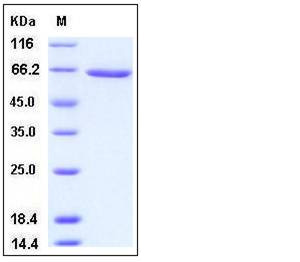Human XRP2 / RP2 Protein (GST Tag)
DELXp11.3,KIAA0215,NM23-H10,NME10,RP2,TBCCD2,XRP2
- 100ug (NPP2470) Please inquiry
| Catalog Number | P11092-H09B |
|---|---|
| Organism Species | Human |
| Host | Baculovirus-Insect Cells |
| Synonyms | DELXp11.3,KIAA0215,NM23-H10,NME10,RP2,TBCCD2,XRP2 |
| Molecular Weight | The recombinant human XRP2/GST chimera consists of 575 amino acids and predicts a molecular mass of 66 kDa as estimated in SDS-PAGE under reducing conditions. |
| predicted N | Met |
| SDS-PAGE |  |
| Purity | > 95 % as determined by SDS-PAGE |
| Protein Construction | A DNA sequence encoding the human XRP2 (NP_008846.2) (Met 1-Thr 350) was fused with the GST tag at the N-terminus. |
| Bio-activity | |
| Research Area | |
| Formulation | Lyophilized from sterile 50mM Tris, 100mM NaCl, 1mM GSH 0.5mM EDTA, 0.5mM PMSF pH 8.0 1. Normally 5 % - 8 % trehalose, mannitol and 0.01% Tween80 are added as protectants before lyophilization. Specific concentrations are included in the hardcopy of COA. |
| Background | XRP2, also known as Protein XRP2 and RP2, is a member of the TBCC (tubulin cofactor C) family and contains one C-CAP/cofactor C-like domain. This protein is encoded by the RP2 gene in humans. XRP2 stimulates the GTPase activity of tubulin, but does not enhance tubulin heterodimerization. XRP2 acts as guanine nucleotide dissociation inhibitor for ARL3. Defects in RP2 gene are the cause of retinitis pigmentosa type 2 (RP2), also known as X-linked retinitis pigmentosa 2 (XLRP-2). It leads to degeneration of retinal photoreceptor cells. Patients typically have night vision blindness and loss of midperipheral visual field. As their condition progresses, they lose their far peripheral visual field and eventually central vision as well. |
| Reference |
